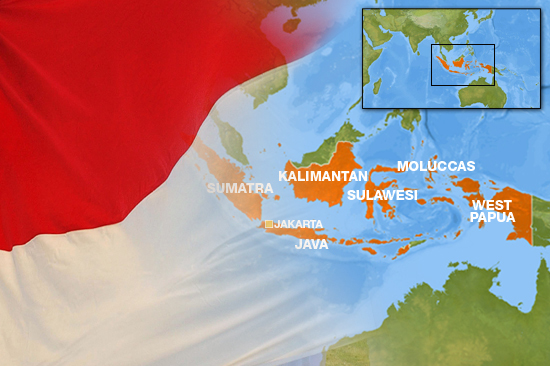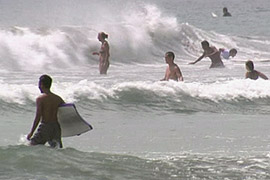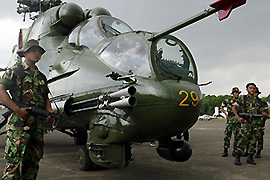Country profile: Indonesia
Key facts and figures on the world’s most populous Muslim nation.

 |
Encompassing some 17,000 islands spread across 5,000km and three time zones, Indonesia is the biggest archipelago in the world.
Until about 500 years ago the various islands were ruled by scattered Hindu and Buddhist kingdoms.
Islam, which first arrived with Arab spice traders in the 13th century, swept through the archipelago, becoming the dominant religion by the time of early Dutch colonialism in the 1600s.
The Dutch were also drawn to Indonesia by the region’s native spices, such as nutmeg and cloves – at the time some of the most valuable traded commodities in the world.
By the early 20th century what is now modern Indonesia was under the colonial rule of the Netherlands and was known as the Dutch East Indies.
After Japanese occupation in World War II, nationalist forces launched a bitter four-year struggle against the return of Dutch colonial rule, finally winning independence for the new nation of Indonesia in 1949.
| Politics |
| Pancasila: The five principles | ||
|
1. Belief in the one and only God 2. Just and Civilised humanity 3. The unity of Indonesia 4. Consultative democracy 5. Social justice for all Indonesians |
According to the constitution, Indonesia‘s political philosophy is based on the five principles known as “Pancasila”, first proposed by Sukarno, the country’s independence leader and first president.
Indonesia is a republic and historically the political system has concentrated power in the hands of the presidency.
Since the fall of former president Suharto in 1998, however, Indonesia‘s political structures have been undergoing major reform, giving more voice to Indonesia‘s two houses of parliament.
The more powerful lower house is made up of 550 seats, currently held by representatives of 17 political parties.
Political reforms have also introduced limits of two terms on the presidency.
Former president Suharto, who took power following a failed coup attempt in 1965 – the exact circumstances of which have never been made clear – ruled Indonesia unchallenged for more than three decades.
He resigned in 1998 in the face of student-led protests triggered by the Asian financial crisis.
Indonesia held its first direct presidential election in 2004, won by the current president, Susilo Bambang Yudhyono.
| Economy |
 |
| Indonesia’s vital tourism industry has been damaged by a series of terrorist attacks |
Indonesia‘s economy was hit hard by the Asian financial crisis in 1997.
The value of the national currency nosedived, millions were thrown out of work, and economic growth – which had averaged nearly 7 per cent in the decade before – ground to a halt.
Ten years later and the economy has regained some lost ground, although the millions who lost their jobs and businesses continue to struggle. Officially about 10 per cent of the population are out of work.
A large part of the government budget is burdened by heavy subsidies on the cost of fuel, rice and electricity. But the removal or reduction of those subsidies is a politically-sensitive issue.
Indonesia‘s main exports include oil and gas, timber products and textiles.
Its economy also depends heavily on tourism, particularly on the island of Bali, although visitor arrivals there were hit hard by the bomb attacks of 2002 and 2005.
The country’s oil industry – one of the oldest in the world – has suffered from decades of waste and underinvestment, with output falling steadily since its peak in the late 1970s.
The government is considering pulling out of the Organisation of Petroleum Exporting Countries (Opec) since it is now a net importer of oil.
| Geography |
 |
| Indonesia is home to more than 70 active volcanoes [GALLO/GETTY] |
Straddling part of the so-called Ring of Fire in the western Pacific, Indonesia sits on one of the most seismically active regions of the world. Earthquakes are common and occasionally severe.
In late 2004, a powerful undersea earthquake off the island of Sumatra triggered a tsunami that swept across much of the Indian ocean, killing an estimated 200,000 people. More than half of the dead came from Indonesia.
Indonesia is also home to dozens of active volcanoes, most of which form part of the Sunda Arc, a 3,000km line of volcanoes stretching from north Sumatra to the Banda sea east of Sulawesi.
While producing occasionally deadly eruptions, the volcanoes also provide Indonesia with some of the most fertile agricultural land on the planet. As a result, volcanoes occupy a prominent place in Indonesian culture.
The country’s environmental landscape ranges from pristine rainforest – much of which is severely threatened by logging and agricultural expansion – to arid semi-desert in the islands of Nusa Tengarra, east of Bali.
The seas surrounding Indonesia are rich in marine life and are home to between 10 and 15 per cent of the world’s coral reefs.
On land, environmental degradation by logging and other industries has given Indonesia the dubious distinction of being home to more endangered species than any other country in the world.
| Society |
| Indonesia: Key dates |
|
1949 – Independence from Dutch colonial rule
1965 – Failed coup leads to Suharto taking presidency
1997 – Asian financial crisis hits, triggering riots and forcing Suharto from power
2002 – East Timor declared independent; Bali nightclub bombing leaves 202 dead
2004 – Asian tsunami kills more than 130,000 in Indonesia
2005 – Government signs Aceh peace deal
Click here for full timeline |
According to official statistics Indonesia is the world’s most populous Muslim nation, with about 88 per cent of its 245 million people professing to follow Islam.
Ethnically and linguistically, however, it is extremely diverse, with more than 20 ethnic groups and more than 300 recorded languages spoken across the archipelago.
Nonetheless, education programmes and the promotion of the national language, Bahasa Indonesia, have helped to create a sense of national identity.
Indonesia also includes a vast range of cultures from the animist hunter-gatherers and practising head-hunters on the island of Borneo to the unique version of Hinduism practised on the island of Bali.
Among the Muslim community there is also a wide range of practice, with many Indonesian Muslims also incorporating pre-Islamic customs and traditions into their spiritual and daily lives.
Indonesia prides itself on its “unity in diversity” – the country’s national motto – but outbreaks of inter-religious and inter-ethnic violence do periodically flare up, most recently in the provinces of Kalimantan, Maluku (The Moluccas) and central Sulawesi.
In many cases these clashes have in part been a legacy of the transmigration policies of previous governments, resulting in clashes between migrants and indigenous communities.
The programme, known as “transmigrasi”, was aimed at resettling millions of Indonesians from the country’s overcrowded heartland, particularly Java, to the less populated outer islands.
| Military |
 |
| Indonesia’s military remain a powerful and influential force [EPA] |
Ever since the independence struggle, Indonesia‘s armed forces have played a central role in the country and its political system.
Under the country’s first president, Sukarno, the military’s central political role was formalised through the concept of dwi fungsi (dual function), giving the armed forces a role in defending the security and integrity of the nation militarily and as a social and political force.
This status became even more entrenched under the rule of Sukarno’s successor, Suharto, himself a former senior general.
Under Suharto the armed forces became a central force in Indonesian politics, with a guarantied allocation of parliamentary seats going to generals.
Human rights groups believe that during the three decades of Suharto’s rule, hundreds of thousands, possibly millions of Indonesians, died at the hands of the armed forces.
Since Suharto’s downfall, political reforms have eroded some of the military’s dominance, but it remains a highly influential force.
The current president, Susilo Bambang Yudhyono, is himself a retired general.
